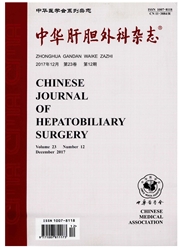

 中文摘要:
中文摘要:
目的 探讨跨膜丝氨酸蛋白酶4(transmembrane protease serine 4,TMPRSS4)在放疗后残余肝细胞癌转移中的作用及机制.方法 建立具有肺转移潜能的人肝癌裸鼠原位模型,模拟临床分割放射治疗.将放疗后残余肝癌组织切除后再种植于正常裸鼠肝脏.6周后处死,测量放疗后再种植肝癌体积,计算其肝内移灶数目及肺转移率.HE染色观察放疗后肝癌组织学形态.Westernblot及RT-PCR检测放疗前后肝癌组织内上皮间质转化(epithelial-mesenchymal transition,EMT)相关基因及TMPRSS4的表达.结果 对照组肝癌切除再种植后42 d,其肿瘤大小及肺转移率分别为(2.25士0.52)cm3和66.7%,而放疗后2d和放疗后30 d残癌切除再种植组,肿瘤大小分别为(1.61±0.51)cm3 (P<0.05)和(2.60±0.61)cm3 (P>0.05),肺转移率分别为12.5% (P<0.05)和100% (P<0.05).对照组及放疗后2d残癌切除再种植组无肝内转移灶,放疗后30 d残癌切除再种植组肝内转移灶数为18±8.05(P<0.05).放疗后30 d残癌组织EMT相关蛋白N-cadherin、Vim-entin及TMPRSS4、SIP1的表达显著高于对照组及放疗结束后2d残癌组织,而E-cadherin表达则显著降低.结论 放疗后残癌的转移潜能先降低后增强.放疗后残癌TMPRSS4表达增加进而诱导EMT的发生可能是后期转移潜能增强重要原因之一.
 英文摘要:
英文摘要:
Objective To investigate the role and mechanism of TMPRSS4 in radiation induced metastasis of hepatocellular carcinoma (HCC).Methods Metastatic model of human HCC was established by orthotopic implantation of histologically intact human HCC tissue into the liver of nude mice.Mice bearing xenografts in liver were killed after radiation and the residual tumors were resected and reimplanted into the liver of normal nude mice.At the end of sixth week,the mice were killed and the histopathological features,tumor volume,intrahepatic and lung metastasis were evaluated.Expression of epithelial-mesenchymal transition (EMT) related genes including N-cadherin,Vimentin,SIP1 and TMPRSS4 were measured by Western blotting and RT-PCR.Results The tumor volume and frequency of lung metastasis of control group was 2.25±0.52 cm3 and 66.7%,respectively.Compared to control group,tumor diameter (1.61±0.51 cm3,P〈0.05) and lung metastasis (12.5%,P〈0.05) were significantly inhibited 2 days after radiation.Whereas,30 days after radiation,tumor growth recovered (2.60±0.61 cm3,P〉0.05) and lung metastasis was enhanced (100%,P〈0.05).There were no intrahepatic metastasis in the control group and in the group of reimplantation of HCC 2 days after radiation,while the tumors from those 30 days after radiation showed enhanced intrahepatic metastasis (18 ± 8.05,P〈 0.01 ),with overexpression of SIP1,N-cadherin,Vimentin and TMPRSS4,and reduced expression of E-cadherin.Conclusion The metastasis potential of residual HCC after radiation was first inhibited and then promoted.Overexpression of TMPRSS4 plays a critical role in radiation induced long-term metastasis of HCC by facilitating EMT.
 同期刊论文项目
同期刊论文项目
 同项目期刊论文
同项目期刊论文
 Risk Factors, Prognosis, and Management of Early and Late Intrahepatic Recurrence After Resection of
Risk Factors, Prognosis, and Management of Early and Late Intrahepatic Recurrence After Resection of 期刊信息
期刊信息
